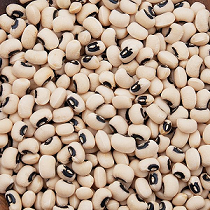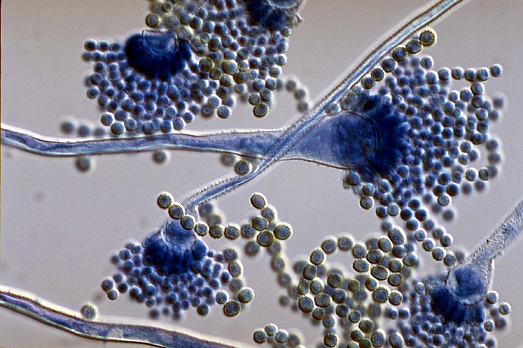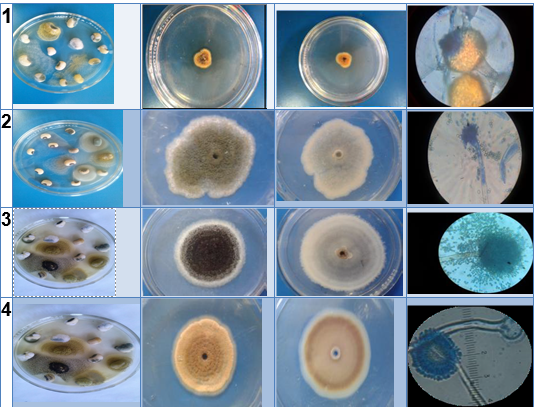A study conducted at the University of Carabobo in Venezuela by the students of Bioanalysis Martínez R. and Nieves A. has had special interest in the medical and scientific world due to the relevance of its results. I would like to show you a summary of their research
“INCIDENCE OF FUNGI ON BEAN GRAINS (Vigna unguiculata [L] Walp) MARKETED IN MARACAY STATE ARAGUA, VENEZUELA ”
Bean grains are one of the most widely consumed legumes worldwide, and they are exposed to several factors that induce fungal colonization, especially of mycotoxin-producing species; which cause serious damage to health. In order to evaluate the incidence of toxigenic fungi associated to bean bean samples (vigna unguiculata [L.] walp), distributed in bulk and commercial brand, direct sowing of one hundred undamaged whole grains was performed, disinfected with hypochlorite from sodium at 1.5% and seeded on the agar culture malt culture medium. The fungal species isolated in the samples with low incidence were Aspergillus flavus, Aspergillus niger, Aspergillus ochraceus, Aspergillus terreus, Penicillium citrinum and Fusarium Verticillioides while Eurotium amstelodami had a high incidence in the trademark sample. The study is of vital importance due to the presence of toxigenic molds in the grains evaluated, indicating that there is a potential risk of contamination with mycotoxins and represents a risk to health, since these grains form the diet of Venezuelans.
Bean
The bean (Vigna unguiculata [L.] Walp) belongs to the Fabaceae family and is made up of 700 genera and 38 species, it is one of the grain legumes included in the diet of the Venezuelan, especially by the peasant population, occupying the

second place after the caraota (Phaseolus vulgaris L.), as far as its preference. Its nutritional importance lies in its content of protein (23%), carbohydrates (56%), fat, fiber, minerals and vitamins (Escalona, 2015; León and Cols., 2013).
The consumption of fabaceae grains such as beans is an important alternative as a source of protein for both vitamins (thiamine, niacin) and minerals (Fe, K, P, Ca) and dietary fibers, and is also related to the decrease in the levels of cholesterol, anemia, blood sugar levels especially in diabetic patients (WHO, 2014).
Fungi and Mycotoxins
Fungi are eukaryotic, unicellular or filamentous organisms and their reproduction is by spores. The cell walls of most fungi contain in their composition chitin and glucans and reproduce sexually and asexually, except for a group of fungi (imperfect) are Deuteromycetes that only reproduce asexually. Fungi can be classified as obligate parasites (biotrophs) and not obligate (necrotrophs and hemibiotrophs) or they can be facultative saprophytes or parasites. There are more than 100,000 species of fungi that are saprophytes but only 10,000 of them are known to cause diseases in plants (INTA, 2013).

Among the main factors that cause the growth of fungi, are the physical factors which are described as: the moisture content of the grain where the amount of water in the environment and substrates are important for the development of fungi , as well as the temperature, which is between 25ºC and 30ºC for its development, and the physical integrity of the grains. Split kernels are more susceptible to fungal invasion and development than whole grains. This is due to a greater predisposition for the fungus to contact the internal part of the grain, which is more vulnerable than the cuticle or external part (Gimeno, 2002).
The chemical factors are associated to the pH since the fungi tolerate a large pH range (2.5 - 7.5), in general they support the acidic medium better than the alkaline, on the other hand the mineral nutrients are related to the composition of the substrate and although iron and zinc are the most important elements for a fungal development, both these and others may be necessary for the production of mycotoxins (Op cit).
The biological factors focus on the presence of invertebrates where the insects act as an agent of dissemination of the mycoflora and therefore contribute to the growth and multiplication of the fungi. The insect's own metabolism raises the moisture content of the substrate (Op cit).
Mycotoxins are toxic secondary metabolites synthesized by fungi of the genera Aspergillus, Penicilllium and Fusarium, which grow on food substrates. Due to its toxigenic capacity, the most important mycotoxins are: Aflatoxins, Ochratoxins, Trichothecenes and Fumonisins (Serrano-colli and Cardona-Castro, 2015).
Most of the potentially toxigenic fungal species detected in bean grains belong to the genera Aspergillus, Penicillium, Fusarium and Alternaria where Aspergillus flavus and Aspergillus niger have been the highest incidence (Narcise and Cols., 2013).
Mycotoxins are considered within the group of the most important food contaminants due to their negative impact on public health, food security and the economy of many countries, particularly developing countries. They affect a wide range of agricultural products, including cereals, nuts, nuts, coffee beans and oilseeds. the contamination with mycotoxins of those susceptible products, occurs as a result of the environmental conditions in the field, as well as the inadequate conditions in which the operations of harvest, storage and processing of the product are carried out (FAO, 2010)
Mycotoxins can contaminate food and the raw materials used for its preparation, so that when consuming such contaminated food, it causes a toxicological disorder called mycotoxicosis in humans and animals (Elika, 2010).
Exposure to these occurs mainly by ingestion, but also by skin contact, by inhalation and often health professionals do not recognize mycotoxicosis so their toxic metabolites can cause carcinogenesis, teratogenesis, immunosuppression and clinical signs of neurotoxicity, nephrotoxicity , hepatotoxicity, myelotoxicity, pulmonary and endocrine toxicity. The most important mechanisms for the appearance of such manifestations are oxidative stress and genotoxicity induced by Mycotoxins (Peraica and Cols., 2010).
The toxigenic fungi are an object of worldwide interest, due to the important economic losses that cause their effects on human and animal health. The impact of mycotoxins is very difficult to determine, due to lack of information regarding the number of patients and deaths, means and levels of contamination, and the existence or not of regulation by different nations (Chavarri, 2014).
In Venezuela and worldwide there are few published studies on the incidence of fungi in legume grains and especially in beans, taking into account that in our country there is no information on the investment made in the control of mycotoxins and the losses in the productivity that its pollution generates in animals and crops. In addition, the impact that these metabolites can have on the health of the population is unknown (Chavarri, 2010, Narcise and Cols., 2013).
EXPERIMENTAL PROCEDURE
Location and collection of samples
The research was carried out in the Micotoxicology Laboratory of the Institute of Chemistry and Technology of the Faculty of Agronomy of the Central University of Venezuela (UCV). Bean grain samples were analyzed for human consumption, the samples were made up of two commercial brands and two in bulk. The grains were purchased in supermarkets and popular markets located in the city of Maracay, Aragua state.
Determination and quantification of total fungi and by species
The incidence of molds was determined and quantified, using the direct sowing method of one hundred selected grains (whole grains, intact, without mechanical damage or by insects) in total of one kilogram of each sample, under a laminar flow hood, disinfected seeds with sodium hypochlorite (NaClO) at 1% for 30 seconds and washed three times with sterile distilled water. subsequently dried in Petri dishes with sterile filter paper and seeded 12-13 grains / plate on the surface of agar agar malta agar medium (MSA) of pH 5.8 were incubated for 8 days at room temperature (± 24) -26 ° C) with alternating 12 light / dark hours. After the incubation period, the total number of colonized grains and the mold species with the highest incidence were evaluated with the stereoscopic magnifying glass.
The degree of total incidence of fungi and by species in particular was determined, using the Mazzani scale (1998) according to the incidence: low (<15%), intermediate (15-30%) and high (> 30%).
Identification of fungi
It was carried out based on the taxonomic description (macroscopic and microscopic).
The isolated fungal species were seeded on plates with the Czapeck agar medium at pH 5.8, under a laminar flow hood.
The plates were incubated in sterile hermetic bags for eight days, at room temperature and with alternating 12 light and 12 dark hours.
After the incubation time had elapsed, the colonies obtained according
to the characteristic of growth, presence of rings, diameter and color in the upper and lower face of the colony, immersed or aerial mycelium and the presence of exudates were described macroscopically.
In the microscopic evaluation, the fungal structures of taxonomic interest (conidia, conidiophores, métula, phialides, conidial head, among others) were measured, each structure was measured 100 times and then an average was obtained. Scotch tape.

We found the macroscopic and microscopic description of the isolated and identified species in the bean grain samples.
CONCLUSIONS
- Bean grains are an ideal substrate for the growth of molds, since a high total fungal incidence was evidenced. Nine mold species of the genera Aspergillus, Penicillium, Fusarium and Eurotium were isolated and identified.
- The presence of toxigenic molds in the grains evaluated indicate that there is a potential risk of contamination with mycotoxins. Therefore, the quantification of mycotoxins in these samples is necessary.
RECOMMENDATIONS
- Determine the toxigenic capacity of the isolated fungal species in this investigation.
- Detect and quantify mycotoxins in bean samples, to corroborate their safety for human consumption. Likewise, it is necessary to monitor the critical control points during the cultivation, pre-harvest, harvest, post-harvest and storage of the grains and / or seeds, to reduce fungal invasion and the possible synthesis of mycotoxins.
It is important to highlight that the research was supervised by Professor Marleny Chavarri as a scientific tutor and Yenny Alviárez as methodological tutor
Intereasting post @j-Davis
GRACIAS!
Thanks for your comment.
Congratulations @j-davis! You received a personal award!
Click here to view your Board of Honor
Do not miss the last post from @steemitboard:
Congratulations @j-davis! You received a personal award!
You can view your badges on your Steem Board and compare to others on the Steem Ranking
Vote for @Steemitboard as a witness to get one more award and increased upvotes!